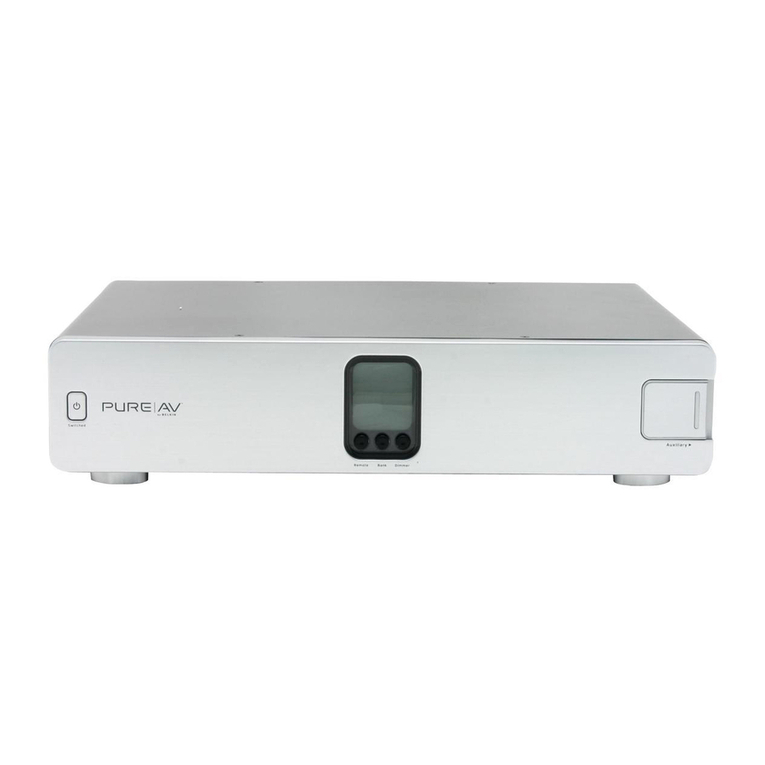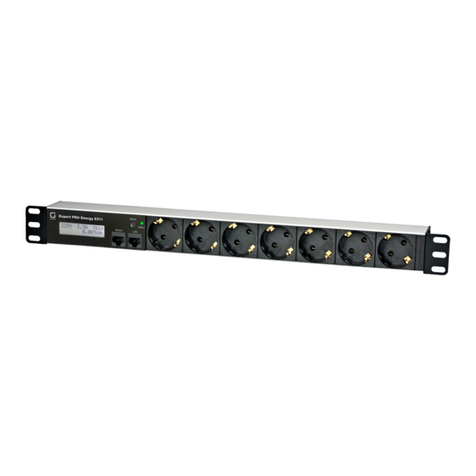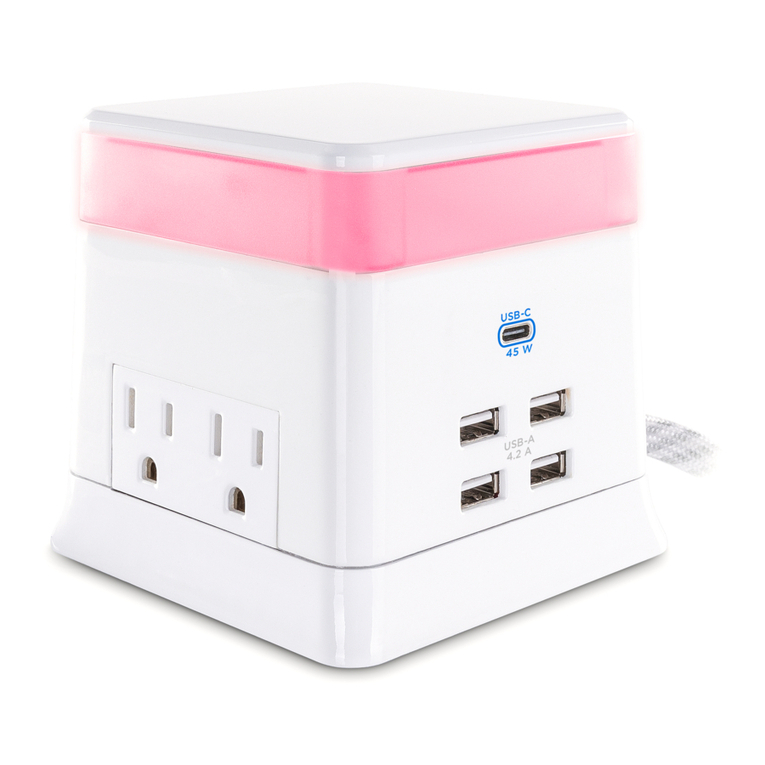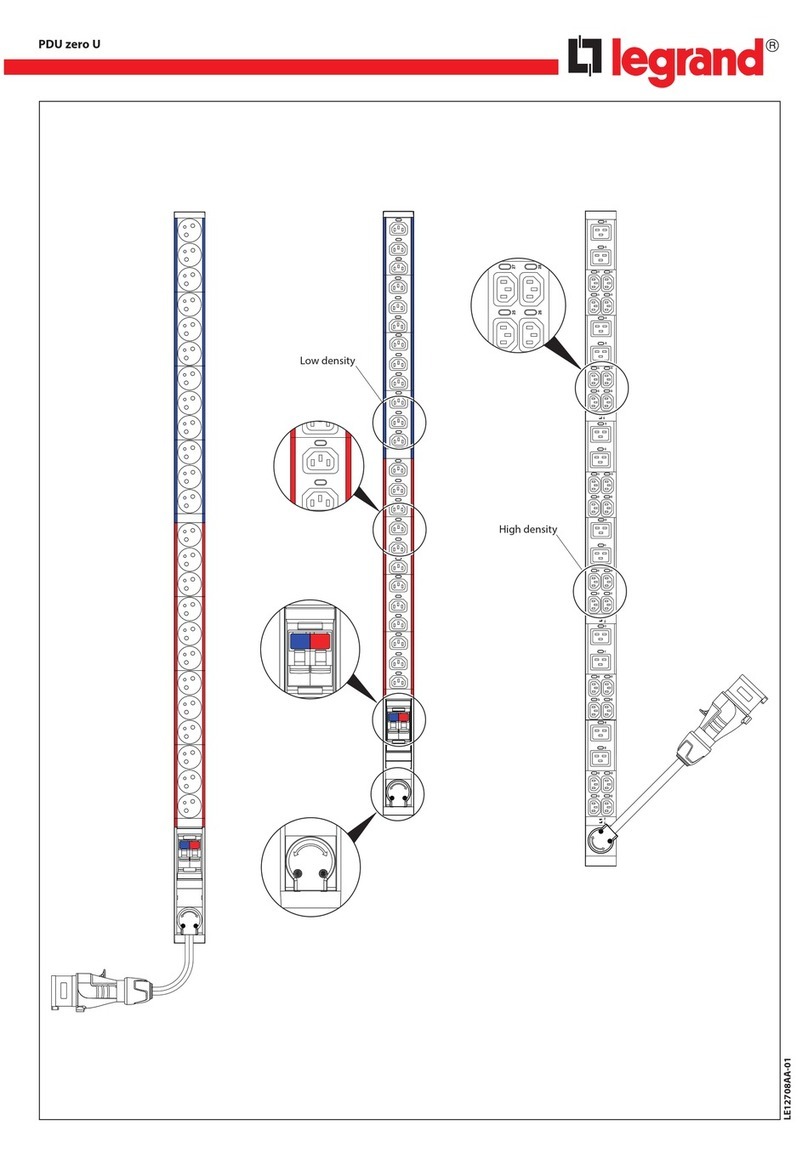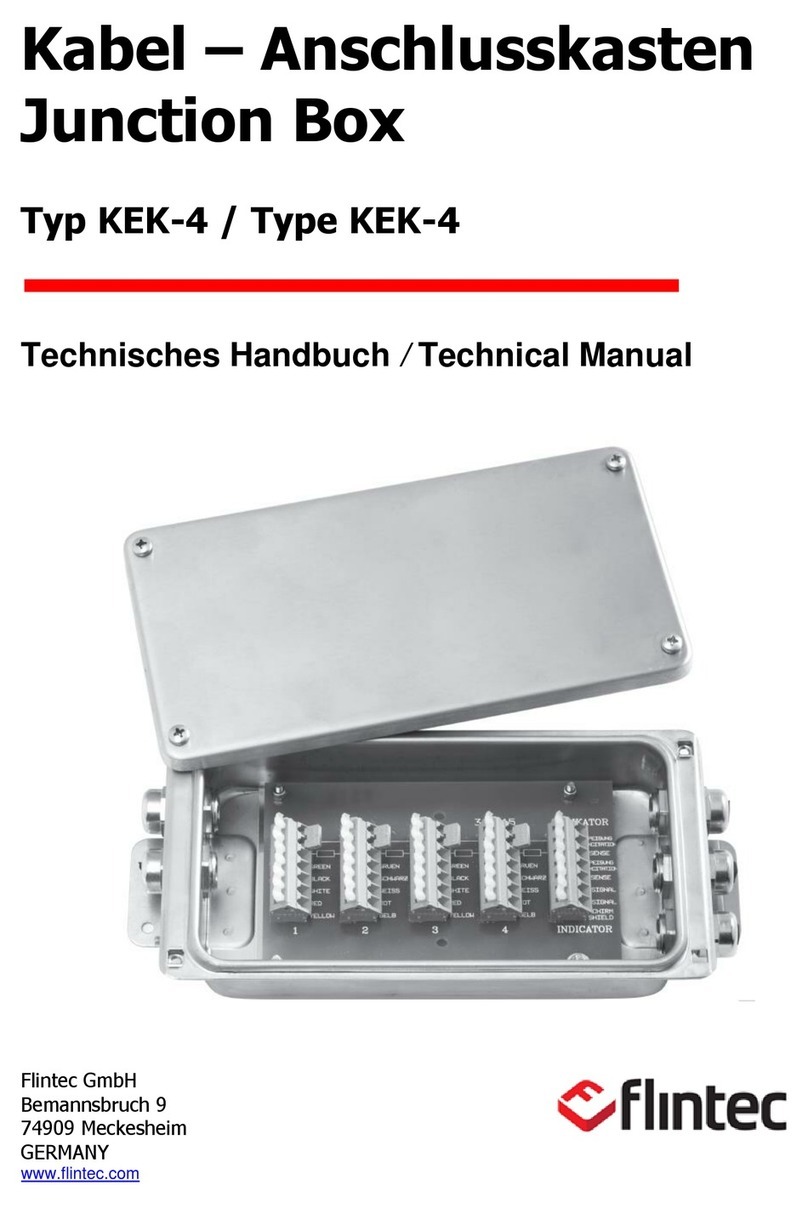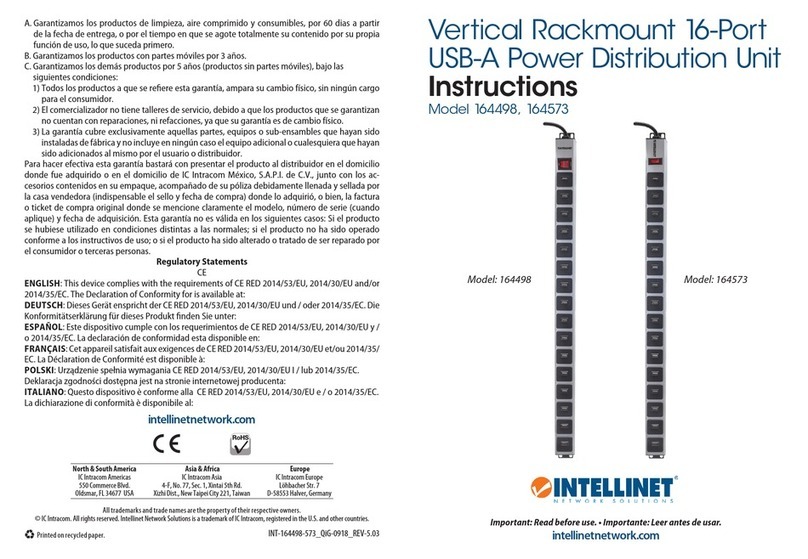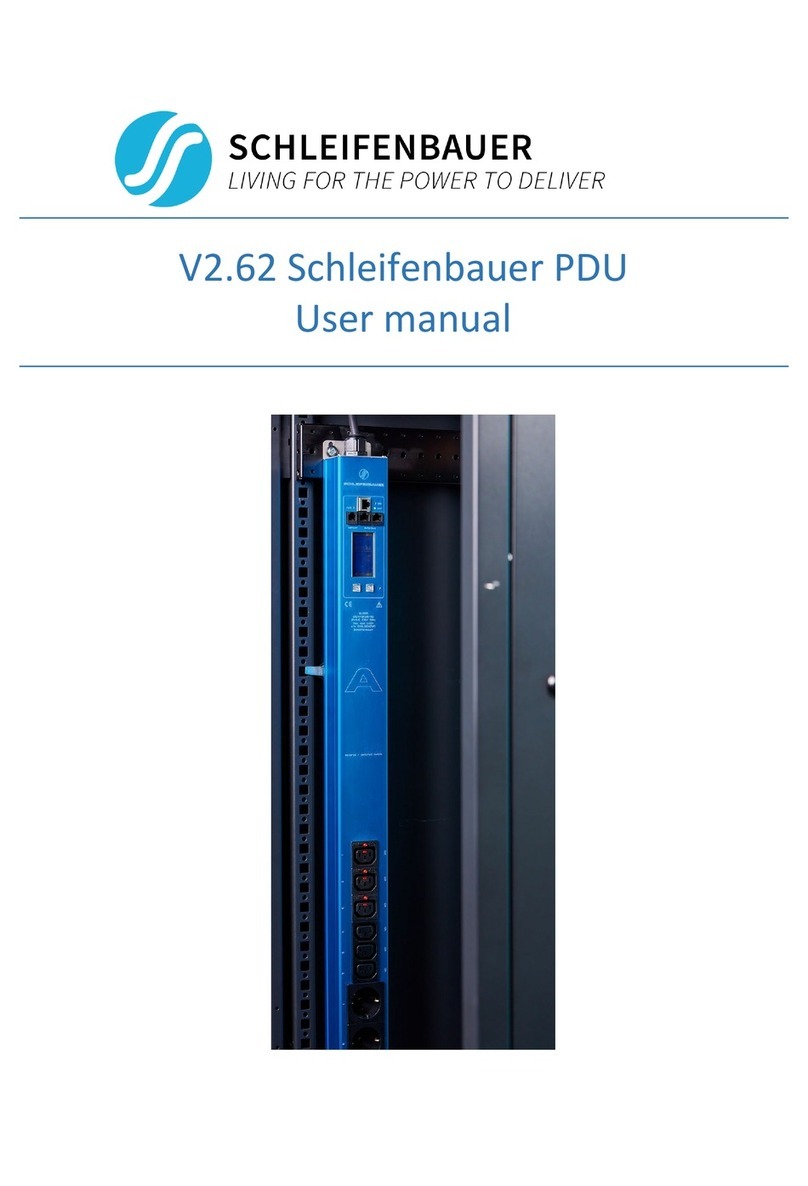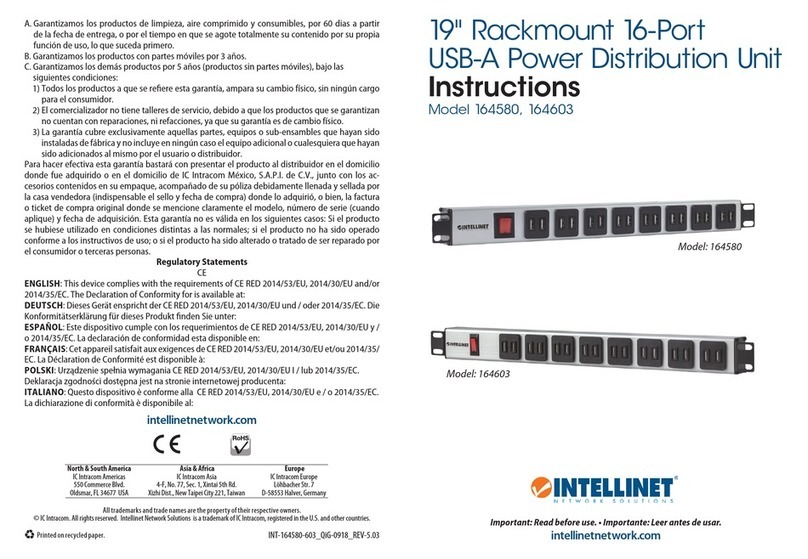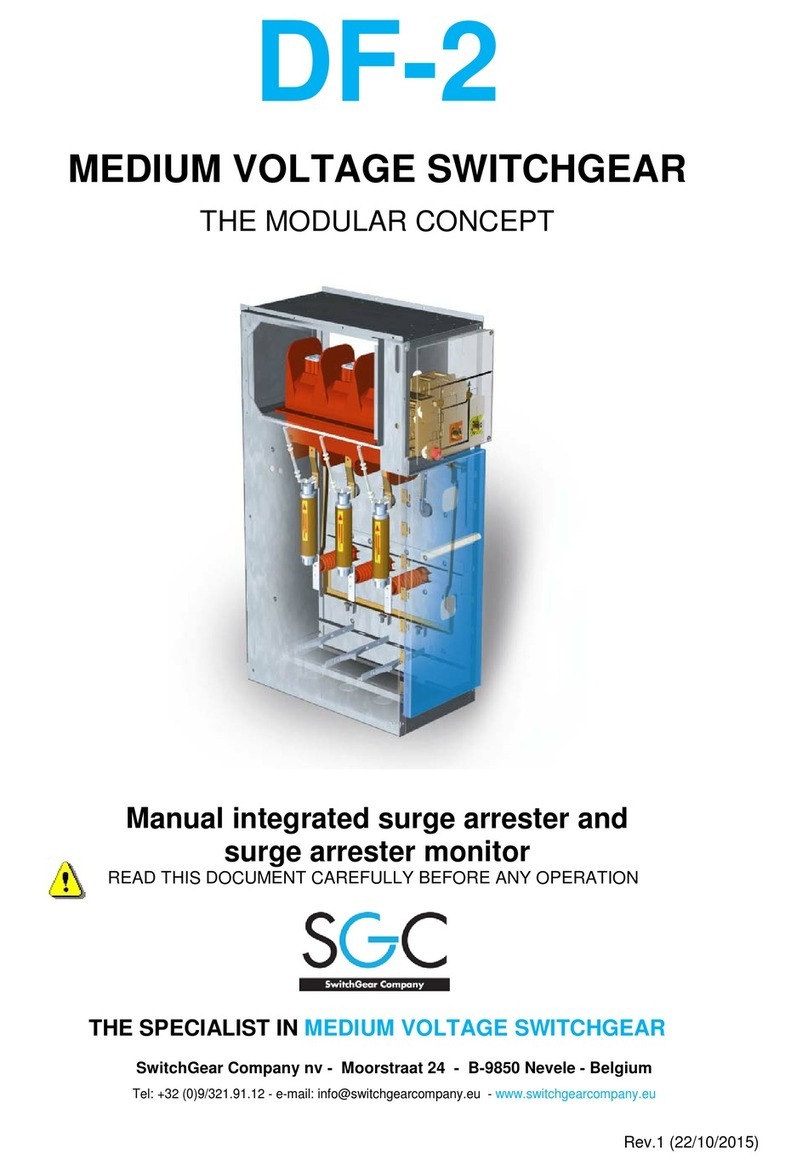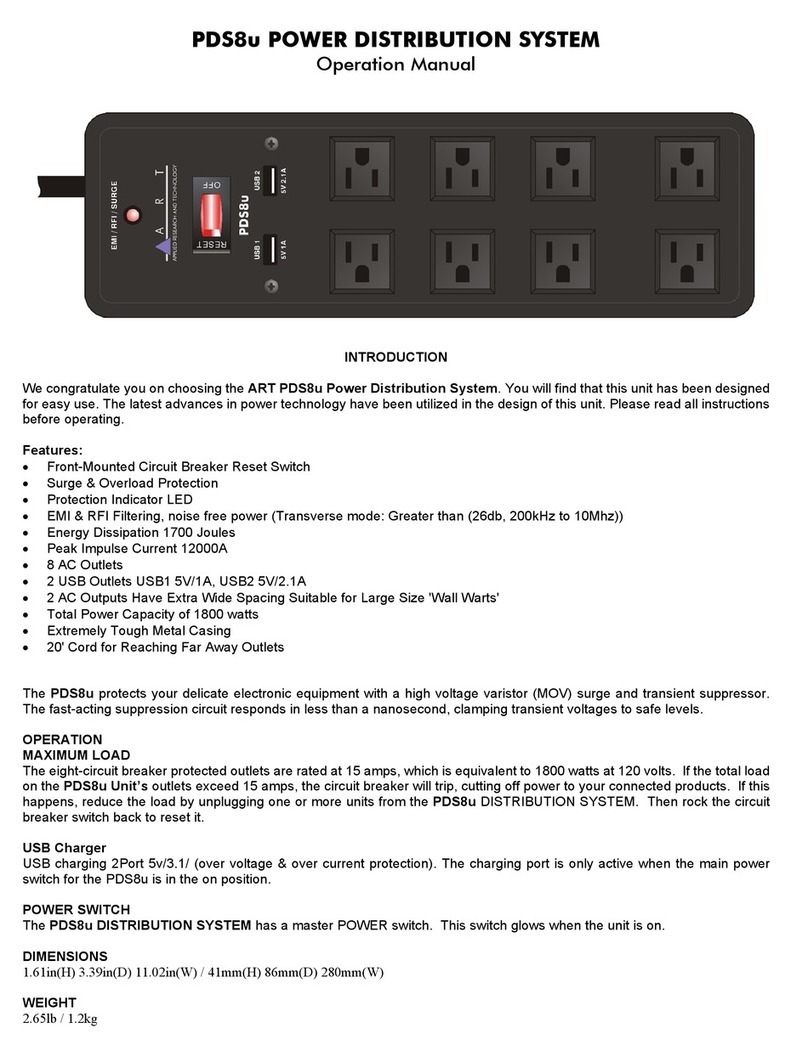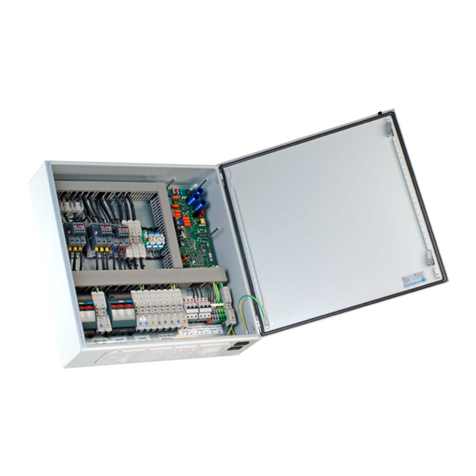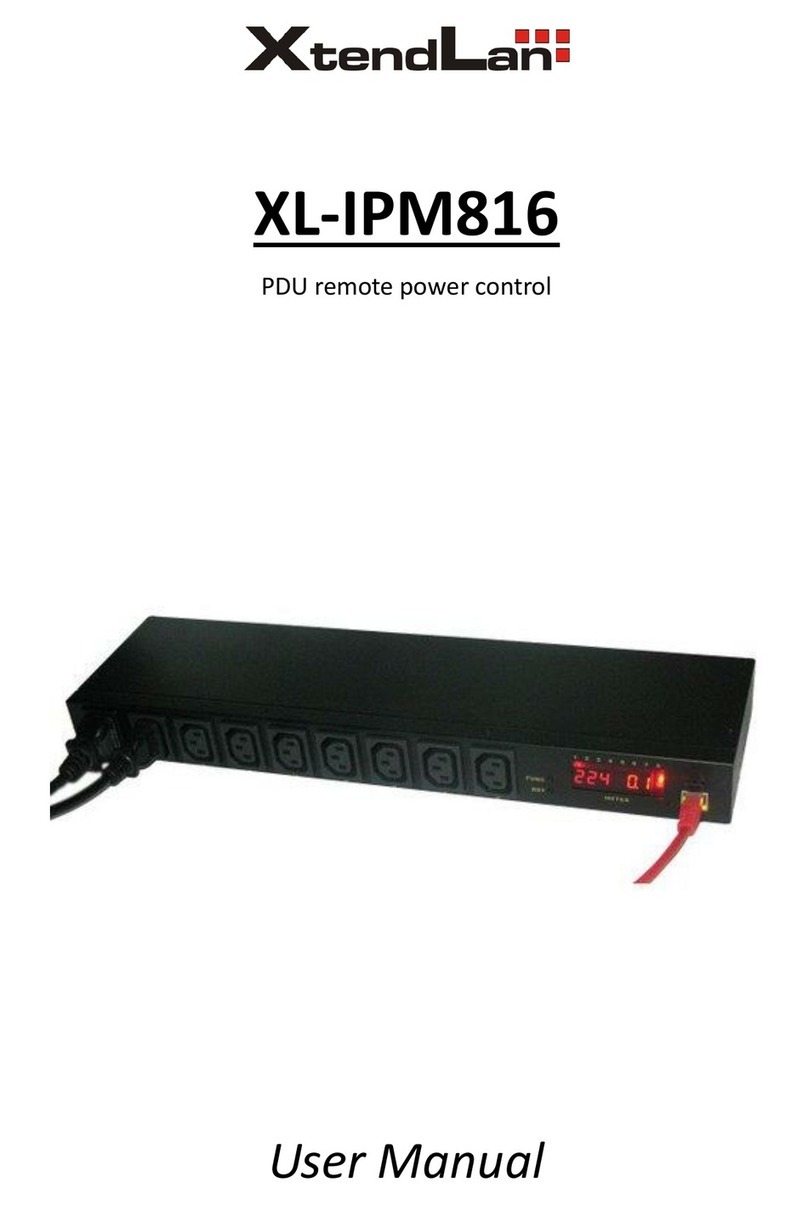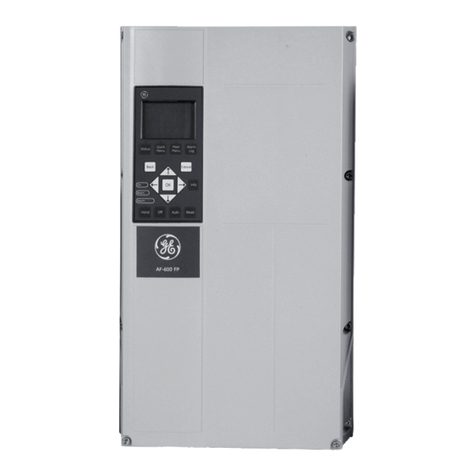KUSSMAUL PDS-100 User manual

170 Cherry Ave.,
West Sayville,
New York 11796
Phone: 800-346-0857
Fax: 631-567-5826
www.kussmaul.com
Manual Part #: M-KPDS100
As of June 2013
Power Distribution System
User’s Manual
Model:
PDS-100
Section Page
Product Overview........................................... 1
I) General Information........................................ 2
II) Important Safety Information.......................... 2
III) Installation...................................................... 3
A) Materials Provided................................ 3
B) Location................................................ 3
C) Mounting............................................... 3
D) System Expansion - Parallel Units....... 3
IV) Wiring Instructions & Diagrams...................... 3
V) Load Group Power Activation Programming.. 6
VI) Operation....................................................... 9
Default Settings......................................... 9
VII) Specications................................................. 9
VIII) Troubleshooting............................................. 10
IX) Warranty......................................................... 11
X) Dimensional Drawing..................................... 12

170 Cherry Ave.,
West Sayville,
New York 11796
Phone: 800-346-0857
Fax: 631-567-5826
www.kussmaul.com
+12V DC Battery In/
Parallel Bus Tie Point
Ignition Sense (+)
Terminals, 1/4” Male
Fast-On
Battery Input OK (Green)
Circuit ID #
ATC/ATO Fuse
20 Amp Max.
Fuse Ok LED (Green)
Battery Ground/
Parallel Bus Tie Point
+12V Load Terminals
Dip Switch Modules Set
Power Activation Parameters
Per Load Group:
•Powered Only With
Ignition
•Timed Disconnect
•Always On with Adjustable
Load Group LVD
•Always On, No Load
Group LVD
Product Overview
1
Status LED (Red)
•ProgrammingStatus
•IgnitionOFF
•OverVoltageShutdown
•UnderVoltageShutdown
INPUT
POWER
POWER
MODE
LOAD GROUP 1
1 2
LOAD GROUP 2
3 4
LOAD GROUP 3
5 6
PDS-100
POWER DISTRIBUTION SYSTEM
www.kussmaul.com • 800-346-0857
(+)
LOADS
(-) POWER
GND
IGN
INPUT (+)
LOAD GROUP 1 LOAD GROUP 2 LOAD GROUP 3
CAUTION: 20 AMPS MAX ATC/ATO FUSE
•RATING: 12V DC, NEG. GROUND, 100 AMPS MAX
•INSTALL 100A FUSE/CIRCUIT BREAKER ON + INPUT
•REPLACE PROTECTIVE COVER AFTER INSTALLATION/SERVICE
Silk Screen: PDS-100
P/N: SS15716-0
June 7, 2013
TM
Ground Load Terminals
Master Low Voltage
Disconnect Disables
Power to All Loads
When Input Voltage is
Less Than 10.5V DC

170 Cherry Ave.,
West Sayville,
New York 11796
Phone: 800-346-0857
Fax: 631-567-5826
www.kussmaul.com
I) GENERAL INFORMATION
The PDS-100 provides emergency and public safety vehicle electronics installers with a convenient, efcient, safe and
dependable method for adding distribution, circuit protection, timer and power control to communication electronics and
electrical devices. Its compact size allows installation under consoles and in interior compartments (not intended for
installation in engine compartment). As a standalone power distribution system, there is no interference with the vehicles
factory installed wire harness; the PDS wires directly to the vehicle battery. Each of the 6 circuits are individually fused
(ATO /ATC type) and wired to power-on/fuse fail indicator LED’s which simplies circuit troubleshooting.
The 6 distribution circuits are congured into 3 load groups of two, power control to each individually group is
programmable via 4 user selectable options:
• Always ON
• ON with Ignition, OFF with Ignition
• ON with Ignition, Timed OFF (adjustable time interval) with Ignition
• ON with Battery, OFF upon Low Voltage sense LVD (adjustable disconnect point) with 20 second delay
In addition, the unit contains a master Under Voltage sense circuit that de-activates the whole unit @ 10.5V to save the
vehicle battery from extreme discharge, and automatically reconnects when battery charge recovers. Contact factory for
custom Master Under Voltage Shutdown threshold.
A Hight Voltage Shutdown circuit is also built-in that de-activates the whole unit @ 16.0V protecting loads against damage
due to malfunctioning alternators.
System capacity can easily be expanded by wiring additional PDS in parallel (18 circuits maximum), see options below.
Optional Accessories
1) Parallel Bus Bar Kit allows up to three PDS-100s inputs to be paralleled for additional circuits. One kit required
for two PDS-100s, two kits for three PDS-100s. Order model PBK, part number 390-5723-0.
2) Parallel Load Terminal Kit allows two output circuits in the same Load Group to be paralled for loads that exceed the
single circuit, 20 amp capacity, providing up to a 32 amp circuit. One kit includes one fork terminal with hardware
to allow one heavy cable to land on to two +12V load terminals of the same Load Group. Load ground cable connects
to single #6 screw located on the Battery Ground bar. Order model PTK, part number 390-5725-0.
II) IMPORTANT SAFETY INFORMATION
CAUTION:
• Read and fully understand the installation/operation manual before making any wiring connections.
• To avoid reverse polarity conrm correct polarity before connecting cables to PDS-100.
Stud ends are color coded with polarity:
RED = +12 VDC/Positive
BLACK = - 12 VDC/Negative
• Install fuse/circuit breaker on +12 VDC power feed/input wire to PDS-100. Size to match your loads and wire size.
• Connect high current feeder cables to the provided ¼” studs only.
• Run separate, dedicated ground cable (- 12 VDC) to PDS-100 ground stud. Do not rely on chassis frame
for grounding connections.
• 20 Amp maximum fuse. Use ATC/ATO style fuses only.
• 12 VDC nominal negative ground systems only
• Do not exceed 100 Amps total load per unit
• Replace protective cover after installation
2

170 Cherry Ave.,
West Sayville,
New York 11796
Phone: 800-346-0857
Fax: 631-567-5826
www.kussmaul.com
3
III) INSTALLATION
IMPORTANT NOTICE:
Ifnotusingthefactorydefaultprogramming(seepage9,SettingtoFactoryDefaults),werecommendrst
programming the PDS-100 on a bench for convenience before installation. See page 6, Section V - Load Group
Power Activation Programming.
A) Materials Provided
Qty. Description
1 Installation/Operation Manual (M-PDS100)
1 PDS-100 Power Distribution System
1 Protective plastic cover
1 7” jumper wire with 1/4” female fast-on and ring terminal - use to jumper power from input bus to IGN. terminal
when programming unit on bench
2 Cover attachment screws, nylon, black
4 Sheet metal mounting screws, #10 x 1/2”, self tapping, Phillips Pan Head, S.S.
1 ¼” fast on terminal, 90°, insulated (Ignition sense)
1 Programming data card and holder to record settings entered
1 Rubber boot (+ battery/power feed)
Note: Fuses not provided
B) Location
Select position in the interior of the vehicle where there will be ample space for wire routing and access to the fuses,
and where it will not be subjected to extreme heat, moisture – liquids, or impact by tools or other items stored in the
compartment.
C) Mounting
Always attach to the vehicle metal frame so that it cannot come off in an accident or heavy breaking situations. Use
provided self-tapping sheet metal screws (4 ea). Mount with fuse side up. Do not mount under the hood in engine
compartment.
D) System Expansion - Parallel Units
Circuit capacity can be expanded by wiring a second and third PDS unit to the rst (see Figure 2) each additional PDS
provides 6 additional load circuits (18 circuits maximum).
IV) Wiring Instructions & Diagrams
Refer to Figure 1 wiring diagram for a single unit wiring & Figure 2 for multiple unit wiring.
Refer to Tables 1, 2 & 3 on page 5 for recommended wire size for input power feed, load wiring & multiple unit input power
feed.
Battery
CAUTION: Install a fuse or circuit breaker on the positive (+) battery power feed wire as close to the battery as possible
in order to protect the input power feed wires. Size fuse or circuit breaker 125-150% of the maximum load current.
For single PDS-100 installations, see Table 1 “Recommended Input Power Feed Wire Size”. Identify the total amperage of
all loads to be connected to PDS-100 and then identify recommended wire size based on the cable distance between the
vehicle battery and the PDS-100 mounting location.
Note: For any wire runs that fall between wire length shown in tables on page 5, use the longer wire run to determine wire
size.
Slide provided rubber boot over positive (+) battery feed cable before crimping 1/4” stud.
For multiple PDS-100 installations, refer to Table 3 “Recommended Input Power Feed Wire Size for Multiple Units” for

170 Cherry Ave.,
West Sayville,
New York 11796
Phone: 800-346-0857
Fax: 631-567-5826
www.kussmaul.com
4
battery wire size.
Use 1/4” crimp ring terminals to make the wire connection to the +12V and ground input studs on single PDS-100
installations and 5/16” crimp ring terminals (Parallel Bus Bar Kit, model PBK) for multiple PDS-100 installations. Slide
rubber boot over positive (+) stud after securing cable to stud.
Loads
CAUTION: Maximum load group circuit fuse value is 20 amps. Fuses should be sized to 125-150% of the load current to
prevent nuisance fuse blowing.
Refer to Table 2, “Recommended Circuit Load Wire Size” for recommended wire size for each load. Use ring or fork crimp
terminals to make the wire connections to the +12V load terminal block and ground load terminals.
Ignition
A wire size of 18 AWG or greater should be used to make the ignition input connection to the PDS-100. An insulated,16/14
AWG, 1/4” female fast-on (90˚) is provided.
Figure 1: Single Unit Wiring Drawing
+12V IGNITION
SIGNAL
ON>5V
OFF<5V
(+) (-)
TO TYPICAL LOAD
()
+
_
+12 VOLT
BATTERY
FUSE OR
CIRCUIT BREAKER
20
20
10
20
20
10
FUSE OR CIRCUIT BREAKER
SIZED TO YOUR LOAD, NO
LARGER THAN 100 AMP
20 AMPS MAX
PER CIRCUIT
Optional Parallel Load Terminal
Kit provides single, high power
32 amp circuit by paralleling
output of two circuits

170 Cherry Ave.,
West Sayville,
New York 11796
Phone: 800-346-0857
Fax: 631-567-5826
www.kussmaul.com
Figure 2: Multiple Unit Wiring Drawing
Table 1: Recommended Input Power Feed Wire Size - Single Unit
Max. Total Load
Current Amps
Wire Size (AWG) vs Wire Length (3% drop)
<5 ft. 5-10 ft. 10-15 ft. 15-20 ft. 25-30 ft.
25 #10 #6 #6 #4 #2
50 #6 #4 #2 #2 #0
75 #6 #2 #1 #0 #3/0
100 #4 #2 #0 #2/0 #4/0
Table 2: Recommended Circuit Load Wire Size
Individual Circuit
Load Current
Wire Size (AWG) vs Wire Length (10% drop)
1-5 ft. 5-10 ft. 10-15 ft. 15-20 ft. 20-30 ft.
5 18 18 18 16 14
10 18 16 14 14 12
15 18 14 12 12 10
20 16 14 12 10 8
Table 3: Recommended Input Power Feed Wire Size for Multiple Units
No. of PDS-100 Units/
Max. Load Current
Wire Size (AWG) vs Wire Length (5% drop)
<5 ft. 5-10 ft. 10-15 ft. 15-20 ft. 20+ ft.
2/200 Amps #2 #0 #2/0 #3/0 Not Recommended
3/300 Amps 2 x #2 2 x #0 2 x #0 2 x #2/0 Not recommended
5
(+) (-)
TO +12V BATTERY
FEED
300 AMP(MAX)
FUSE OR CKT. BKR.
TO (-)BATTERY
FEED
TO TYPICAL LOAD
PARALLEL BUS KIT(PBK)
PARALLEL BUS KIT(PBK)
IGNITION-SIGNAL
JUMPERS
+12V IGNITION
SIGNAL
ON>5V
OFF<5V
20
20
10
20
20
10
20
20
10
20
20
10
20
20
10
20
20
10
(OPTIONAL)
(+)
(-)
TO TYPICAL HIGH
CURRENT (32A MAX.)
LOAD
{

170 Cherry Ave.,
West Sayville,
New York 11796
Phone: 800-346-0857
Fax: 631-567-5826
www.kussmaul.com
6
V) LOAD GROUP POWER ACTIVATION PROGRAMMING
Switch Guide
Programming Overview
The PDS-100 can be programmed to independently disconnect the 3 Load Groups based on various selected conditions.
There are 3 input elements to the programming process
1) Dip-Switches
Programming is provided though three sets of dip-switch modules. One per each Load Group. Each set is divided into two
sections. The rst section, made up of switches 5 & 6, is for selecting the power activation MODE to the Load Group. The
second section, made up of switches 1 through 4, is for setting either a TIMER duration or Low Voltage Disconnect and
reconnect (LVD) level of the Load Group (dependent on MODE selected). Use a screwdriver or pen to adjust dip switch
positions; there are two positions - up and down.
2) SET Button
This switch is used to put the PDS-100 into programming mode and save settings to memory. Also used for resetting the
PDS-100 to factory defaults (see Setting to Factory Defaults on page 9).
3) RESET Button
This switch resets the microcontroller. Use it to exit the programming mode without saving any settings and when resetting
the PDS-100 back to factory defaults. WARNING: pressing the RESET switch will momentarily interrupt power to loads.
Programming the Load Group Relays (easier performed on test bench rather than in vehicle)
Note: A short programming jumper wire is provided to aid in programming the PDS-100.
Before programming ensure 12 volt power is properly applied to unit. Connect (+) power to (+) INPUT stud and the (-)
power return to the (-) ground bus stud. The PDS-100 will not power up unless input power is above 10 volts.
Programming
Once the battery is rst connected to the PDS-100, the microcontroller operates at the factory default settings. To change
any of the settings, the PDS-100 will rst need to be set to programming mode. To do this:
1) Jumper the IGN-In terminal to the (+) INPUT bus using the programming jumper wire provided, then press and hold the
SET button until the red status LED begins ashing.
2) Release the button and LED will stay illuminated.
The PDS is now in programming mode. Note: if programming mode has been entered unintentionally or if you don’t
want to save any changes, press the RESET switch at this point to abort programming mode. Pressing reset will
momentarily interrupt output voltage of all Load Groups.
Load Group Activation Selection
Each of the three Load Group relays can be programmed, independent of each other, to one of four activation modes
using dip-switch positions 5 & 6 (refer to the Switch Guide).
Dip Switch Module
INPUT
POWER
POWER
MODE
LOAD GROUP 1
1 2
LOAD GROUP 2
3 4
LOAD GROUP 3
5 6
PDS-100
POWER DISTRIBUTION SYSTEM
www.kussmaul.com • 800-346-0857
(+)
LOADS
(-) POWER
GND
IGN
INPUT (+)
LOAD GROUP 1 LOAD GROUP 2 LOAD GROUP 3
CAUTION: 20 AMPS MAX ATC/ATO FUSE
•RATING: 12V DC, NEG. GROUND, 100 AMPS MAX
•INSTALL 100A FUSE/CIRCUIT BREAKER ON + INPUT
•REPLACE PROTECTIVE COVER AFTER INSTALLATION/SERVICE
Silk Screen: PDS-100
P/N: SS15716-0
June 7, 2013
TM
Program
SET
Button
Dip Switch Module Dip Switch Module
Default Reset
Button
UP
Down

170 Cherry Ave.,
West Sayville,
New York 11796
Phone: 800-346-0857
Fax: 631-567-5826
www.kussmaul.com
7
The modes are as follows:
1) ON with Ignition, OFF with Ignition: Circuits will be energized anytime the ignition signal is ≥5 volts and de-energized if
<5 volts (with 1 second delay). When this mode is selected dip-switches 1 through 4 of that relay group have no effect.
2) ON with Ignition, OFF with Timer: Relay will stay energized after the ignition signal reaches <5 volts for a period of time
set by dip-switches labeled 1 through 4 of that relay group.
3) ON with Battery Power, OFF by Load Group LVD: Relay will stay energized until the battery voltage drops below a
specied level for 20 seconds set by dip-switches 1 through 4 of that relay group. The ignition signal has no affect
on this group mode.
4) Always ON: Relay energized no matter state of ignition signal, OFF only by Master Under Voltage Shutdown (UVS).
NOTE: Under Voltage Shutdown (UVS) or Over Voltage Shutdown (OVS) will de-energize all relays in any MODE. If the
UVS or OVS threshold is reached before timer times out, power will be disconnected from load group.
Table 4: Power Activation Selection Table
Mode Description Switch Position
Switch 6 Switch 5
1 IGN ON/OFF Down Down
2 IGN with Timeout Down Up
3 LVD Up Down
4 Always ON Up Up
Timer Duration Selection (MODE 2)
When the Load Group mode is set for mode 2, dip-switch positions 1 though 4 will set the desired timeout duration, which
is the time from when the vehicle IGN is shut off to when the load is disconnected, see Table 5 for timer selection. Timer is
reset when IGN input voltage is again sensed when ignition switch is turned on.
Table 5: Timer Duration Selections
Duration Switch 4 Switch 3 Switch 2 Switch 1
2 min Down Down Down Down
10 min Down Down Down Up
30 min Down Down Up Down
1 hr Down Down Up Up
2 hrs Down Up Down Down
3 hrs Down Up Down Up
4 hrs Down Up Up Down
5 hrs Down Up Up Up
6 hrs Up Down Down Down
7 hrs Up Down Down Up
8 hrs Up Down Up Down
9 hrs Up Down Up Up
10 hrs Up Up Down Down
11 hrs Up Up Down Up
12 hrs Up Up Up Down
13 hrs Up Up Up Up

170 Cherry Ave.,
West Sayville,
New York 11796
Phone: 800-346-0857
Fax: 631-567-5826
www.kussmaul.com
8
LVD Selection (MODE 3)
When the Load Group relay is set for mode 3, dip-switch positions 1 though 4 will set the desired Low Voltage Disconnect
and re-connect trip points. This is the level at which the Load Group is disconnected and re-connected. In this mode, the
ignition signal has no affect on the Load Group operation.
Table 6: Low Voltage Selection
LV Disconnect Reconnect Switch 4 Switch 3 Switch 2 Switch 1
11.8 13.5 Down Down Down Down
11.7 13.5 Down Down Down Up
11.6 13.5 Down Down Up Down
11.5 13.5 Down Down Up Up
11.4 13.5 Down Up Down Down
11.3 13.5 Down Up Down Up
11.2 13 Down Up Up Down
11.1 13 Down Up Up Up
11.0 13 Up Down Down Down
10.9 13 Up Down Down Up
10.8 13 Up Down Up Down
10.7 13 Up Down Up Up
10.6 12.5 Up Up Down Down
10.5 12.5 Up Up Down Up
10.4 12.5 Up Up Up Down
10.3 12.5 Up Up Up Up
Example Settings
Saving and Applying the Dip Switch Settings
Once the dip-switches have been set to the desired positions press and hold the SET switch for 1 second then release to
save to memory. The red status LED will ash for 4 seconds then extinguish. The PDS dip-switch settings are now stored
in memory and the PDS will start operating with the new settings. NOTE: Even if power is completely removed from the
PDS-100 or the reset button is pressed the new settings will not change.
Re-Setting to Factory Defaults
To set PDS to its factory default settings press and hold the SET button, then press the RESET switch for 2 seconds when
the status LED begins to ash. Release the SET button. The PDS is now reset to the factory settings.
SET
BUTTON

170 Cherry Ave.,
West Sayville,
New York 11796
Phone: 800-346-0857
Fax: 631-567-5826
www.kussmaul.com
9
Default Factory Setting:
LOAD GROUP 1
MODE = 1 ON with Ignition, OFF with Ignition
LOAD GROUP 2
MODE = 2 ON with Ignition, OFF with Timer
TIMER = 2 minutes
LOAD GROUP 3
MODE = 3 ON with Battery, OFF with Programmed Voltage Disconnect
LVD SET = 11.5 volts (Reconnect 13.0V)
VI) OPERATION
A) Fuse Installation: We recommend pre-installing fuse values before powering PDS-100. The PDS-100 will accept ATO/
ATC style fuses, 20 Amp maximum rating.
B) Fuse Removal: Firmly grip fuse with ngers or needle nose pliers and pull straight out
C) Fuse OK LED: A green LED next to each fuse will illuminate when a good fuse is installed
Note: If using blown fuse indicating type fuses a minimum load of at least 20 milliamps is required for proper indication
D) Master Under Voltage Shutdown (UVS) & Over Voltage Shutdown (OVS)
UVS - If the INPUT bus voltage drops below 10.5V for more than 20 seconds all Load Group relays will de-energize
and all loads will disconnect from the INPUT bus and will reconnect when battery voltage is restored to 13V.
OVS – If the INPUT bus increases to over 16V all Load Groups relays will de-energize and loads will disconnected
from the INPUT bus and will restore 15V.
E) Input Power and Power Mode Indicators
INPUT POWER LED – indicates the presence of voltage on INPUT bus (>6 volts)
POWER MODE LED – rate of ashing light indicates different power conditions:
OVS: Over Voltage Shutdown, all circuits off – constant ashing at a rate of once every 1 second.
UVS: Low Voltage Shutdown, all circuits off – constant ashing at a rate of once every 2 seconds.
IGN: Ignition not present – quickly ashes 3 times every 2 seconds.
VII)Specications
Electrical:
Input: 12V, neg. ground
Power Consumption: Idle: 8mA, Active: 180 mA/circuit
Maximum Load: 100A per PDS, 20A max. per fuse position
Maximum System: 3 PDS wired in parallel, 18 circuits
Fuse Type: ATC/ATO
Programmable Timer Range: 2 min. – 13 hours
Low Voltage Disconnect Point Range: Selectable per load group, 10.3 to 11.8V (see table 6 for reconnect voltages), 20
second delay
Master Disconnect: High Voltage 16.0V (OVS), Low Voltage 10.5 (UVS), 20 second delay
Operating Temperature Range: -20˚ C to +60˚ C
Mechanical:
Case: Powder coated aluminum
Protective Covers: Battery “+” bus and “+” power out terminals
Dimensions (H x W x D): 5.6” x 4.75” x 3.1”, Weight: 2 Lbs.

170 Cherry Ave.,
West Sayville,
New York 11796
Phone: 800-346-0857
Fax: 631-567-5826
www.kussmaul.com
VIII) Troubleshooting
Problem/Symptom Possible Cause Solution
No power to any of the six outputs 1) No or low (<10V) input power
2) Bad power input ground connection
3) Defective unit.
1) Remove protective plastic cover &
place a dc voltmeter or DMM across
PDS-100 positive & negative power
input studs to verify input voltage. If
no voltage check for blown or tripped
input fuse/circuit breaker.
2) If no power to PDS-100 input and
fuse/breaker is OK, check for loose
ground cable.
3) Contact Kussmaul for RMA.
Load Group set for timed disconnect
turns off too soon
1) DIP switches not set correctly
2) Battery voltage is dropping below
10.0 VDC causing activation of Master
Low Voltage Shutdown circuit
3) Unit may have been reset to Factory
Default settings, thus unit is not
operating according to the dip switch
positions observed.
1) Reset this Load Group for Mode 2:
IGN with Timeout & verify time period
selected, see Section V.
2) Check for low voltage at the
battery terminals. If voltage is low:
recharge. If problems persists check
for faulty alternator or replace battery.
3) Re-program the unit - see page 6.
Load Group set for timed disconnect
does not disconnect
1) DIP switches not set correctly
2) Defective unit
3) Unit may have been reset to Factory
Default settings, thus unit is not
operating according to the dip switch
positions observed.
1) Verify DIP switches for this Load
Group are set for Mode 2: IGN
with Timeout & verify time period
selected, see Section V.
2) Contact Kussmaul for an RMA.
3) Re-program the unit - see page 6.
Ignition controlled circuits not on when
ignition is ON.
1) Ignition terminal on PDS-100 not
receiving +12 vdc when ignition is on.
2) Incorrect Mode programming
selected for this Load Group.
3) Unit may have been reset to Factory
Default settings, thus unit is not
operating according to the dip switch
positions observed.
1) Check ignition wiring, check for
blown ignition source fuse.
2) See Mode selection section on
page 6.
3) Re-program the unit - see page 6.
Load Group set for low voltage
disconnect, disconnects when battery
is not below selected disconnect
threshold
1) DIP switches not set properly
2) PDS-100 input wires under-sized or
too long resulting in excessive voltage
drop
3) Unit may have been reset to Factory
Default settings, thus unit is not
operating according to the dip switch
positions observed.
1) See Table 6 for LVD disconnect
voltage choices
2) See Table 1 ‘Recommended input
power feed wire size’ and increase
wire size or reduce wire length.
3) Re-program the unit - see page 6.
10

170 Cherry Ave.,
West Sayville,
New York 11796
Phone: 800-346-0857
Fax: 631-567-5826
www.kussmaul.com
No output power from individual fuse
output
Blown fuse Determine reason for blown fuse,
correct fault & replace fuse
IX) WARRANTY
All products of Kussmaul Electronics Company Inc. are warranted to be free of defects of material or
workmanship. Liability is limited to repairing or replacing at our factory, without charge, any material or defects
which become apparent in normal use within 3 years from the date the equipment was shipped. Equipment is
to be returned, shipping charges prepaid and will be returned, after repair, shipping charges paid.
Kussmaul Electronics Company, Inc. shall have no liability for damages of any kind to associated equipment
arising from the installation and /or use of the Kussmaul Electronics Company, Inc. products. The purchaser, by
the acceptance of the equipment, assumes all liability for any damages which may result from its installation,
use or misuse, by the purchaser, his or its employees or others.
11

170 Cherry Ave.,
West Sayville,
New York 11796
Phone: 800-346-0857
Fax: 631-567-5826
www.kussmaul.com
X) Dimensional Drawing
12
Table of contents
